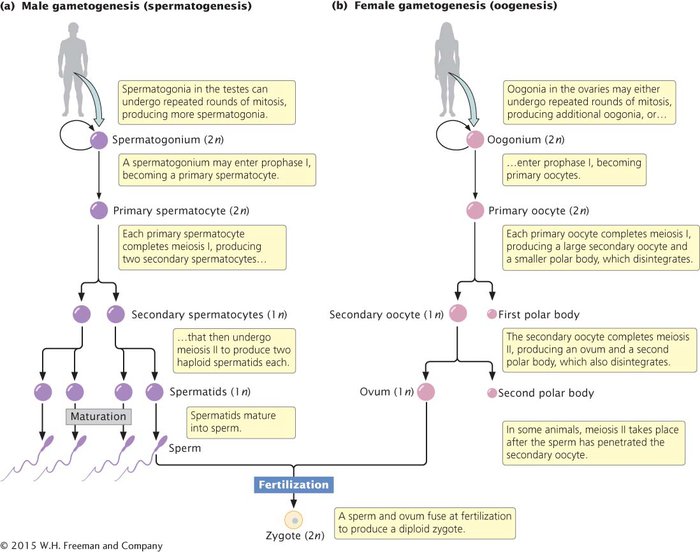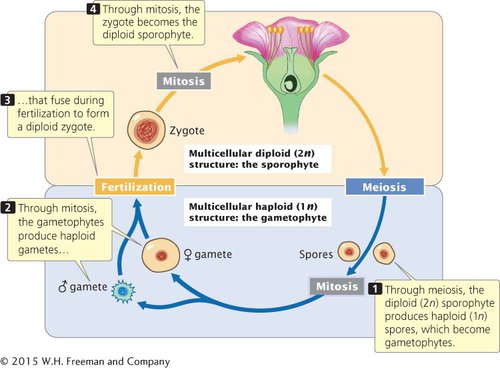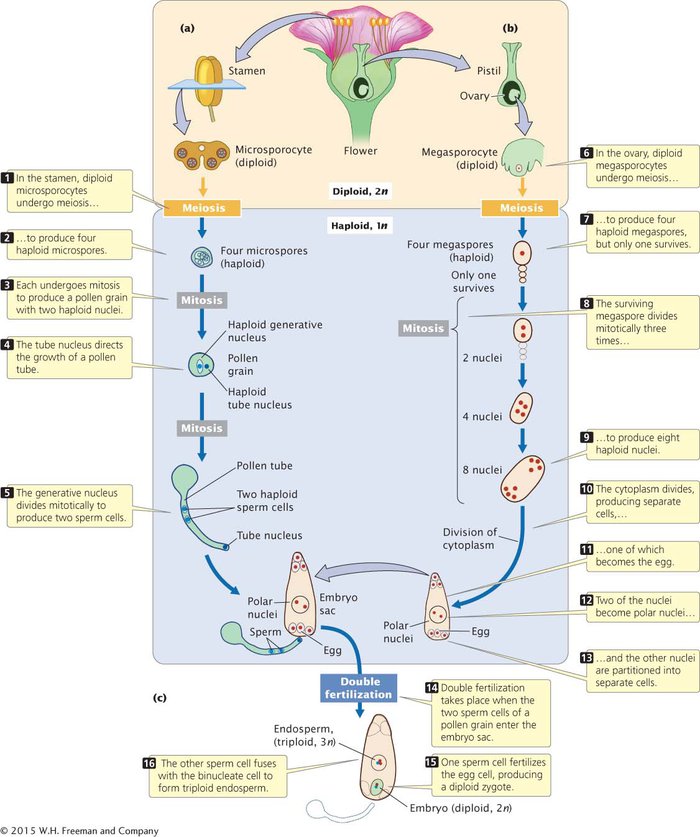Meiosis in the Life Cycles of Animals and Plants
The overall result of meiosis is four haploid cells that are genetically variable. Let’s see how meiosis fits into the life cycles of a multicellular animal and a multicellular plant.
MEIOSIS IN ANIMALS The production of gametes in a male animal, called spermatogenesis, takes place in the testes. There, diploid primordial germ cells divide mitotically to produce diploid cells called spermatogonia (Figure 2.17a). Each spermatogonium can undergo repeated rounds of mitosis, giving rise to numerous additional spermatogonia. Alternatively, a spermatogonium can initiate meiosis and enter prophase I. Now called a primary spermatocyte, the cell is still diploid because the homologous chromosomes have not yet separated. Each primary spermatocyte completes meiosis I, giving rise to two haploid secondary spermatocytes that then undergo meiosis II, with each producing two haploid spermatids. Thus, each primary spermatocyte produces a total of four haploid spermatids, which mature and develop into sperm.

The production of gametes in a female animal, called oogenesis, begins much like spermatogenesis. Within the ovaries, diploid primordial germ cells divide mitotically to produce oogonia (Figure 2.17b). Like spermatogonia, oogonia can undergo repeated rounds of mitosis, or they can enter meiosis. When they enter prophase I, these still-
Here, oogenesis begins to differ from spermatogenesis. In oogenesis, cytokinesis is unequal: most of the cytoplasm is allocated to one of the two haploid cells, the secondary oocyte. The smaller cell, which contains half of the chromosomes but only a small part of the cytoplasm, is called the first polar body; it may or may not divide further. The secondary oocyte completes meiosis II, and, again, cytokinesis is unequal: most of the cytoplasm passes into one of the cells. The larger cell, which acquires most of the cytoplasm, is the ovum, the mature female gamete. The smaller cell is the second polar body. Only the ovum is capable of being fertilized, and the polar bodies usually disintegrate. Oogenesis, then, produces a single mature gamete from each primary oocyte.
CONCEPTS
In the testes, a diploid spermatogonium undergoes meiosis, producing a total of four haploid sperm cells. In the ovary, a diploid oogonium undergoes meiosis to produce a single large ovum and smaller polar bodies that normally disintegrate.
 CONCEPT CHECK 6
CONCEPT CHECK 6
A secondary spermatocyte has 12 chromosomes. How many chromosomes will be found in the primary spermatocyte that gave rise to it?
6
12
18
24
d
MEIOSIS IN PLANTS Most multicellular plants and algae have a complex life cycle that includes two distinct structures (generations): a multicellular diploid sporophyte and a multicellular haploid gametophyte. These two generations alternate: the sporophyte produces haploid spores through meiosis, and the gametophyte produces haploid gametes through mitosis (Figure 2.18). This type of life cycle is sometimes called alternation of generations. In this cycle, the immediate products of meiosis are called spores, not gametes; the spores undergo one or more mitotic divisions to produce gametes. Although the terms used for this process are somewhat different from those commonly used for animals (and from some of those employed so far in this chapter), the processes in plants and animals are basically the same: in both, meiosis leads to a reduction in chromosome number, producing haploid cells.

 ; male,
; male,  ).
).
In flowering plants, the sporophyte is the obvious, vegetative part of the plant; the gametophyte consists of only a few haploid cells within the sporophyte. The flower, which is part of the sporophyte, contains the reproductive structures. The male part of the flower, the stamen, contains diploid reproductive cells called microsporocytes, each of which undergoes meiosis to produce four haploid microspores (Figure 2.19a). Each microspore divides mitotically, producing an immature pollen grain consisting of two haploid nuclei. One of these nuclei, called the tube nucleus, directs the growth of a pollen tube. The other, termed the generative nucleus, divides mitotically to produce two sperm cells. The pollen grain, with its two haploid nuclei, is the male gametophyte.

The female part of the flower, the ovary, contains diploid cells called megasporocytes, each of which undergoes meiosis to produce four haploid megaspores (Figure 2.19b), only one of which survives. The nucleus of the surviving megaspore divides mitotically three times, producing a total of eight haploid nuclei that make up the female gametophyte, the embryo sac. Division of the cytoplasm then produces separate cells, one of which becomes the egg.
When the plant flowers, the stamens open and release pollen grains. Pollen lands on a flower’s stigma—
CONCEPTS
In the stamen of a flowering plant, meiosis produces haploid microspores that divide mitotically to produce haploid sperm in a pollen grain. Within the ovary, meiosis produces four haploid megaspores, only one of which divides mitotically three times to produce eight haploid nuclei. After pollination, one sperm fertilizes the egg cell, producing a diploid zygote; the other fuses with two nuclei to form the endosperm.
 CONCEPT CHECK 7
CONCEPT CHECK 7
Which structure is diploid?
Microspore
Egg
Megaspore
Microsporocyte
d
We have now examined the place of meiosis in the sexual cycles of two organisms, a typical multicellular animal and a flowering plant. These cycles are just two of the many variations found among eukaryotic organisms. Although the cellular processes that produce reproductive cells in plants and animals differ in the number of cell divisions, the number of haploid gametes produced, and the relative sizes of the final products, the overall result is the same: meiosis gives rise to haploid, genetically variable cells that then fuse during fertilization to produce diploid progeny.  TRY PROBLEMS 32 AND 34
TRY PROBLEMS 32 AND 34